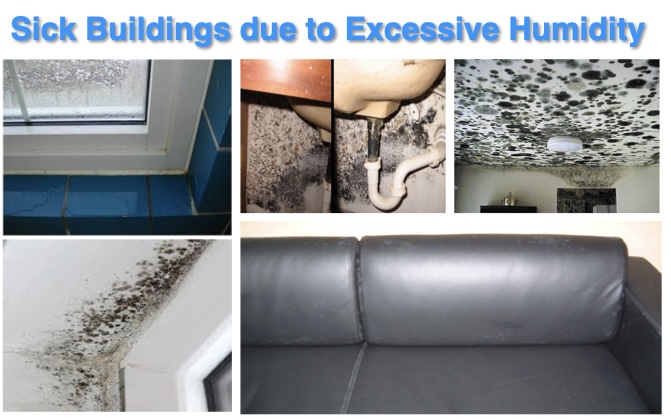Following elements may act separately or in combination to lead to Sick Building Syndrome:
- Chemical contaminants from outdoor sources: Outdoor air that enters a building can be a source of indoor pollution. Pollutants from motor vehicle exhausts, plumbing vents, and building exhausts (bathrooms and kitchens) can enter the building through poorly located air intake vents, windows, and other openings.
- Chemical contaminants from indoor sources: Most indoor air pollution comes from sources inside the building. For example, adhesives, upholstery, carpeting, copy machines, manufactured wood products, cleaning agents and pesticides may emit volatile organic compounds (VOCs) including formaldehyde. Research shows that some VOCs can cause chronic and acute health effects at high concentrations, and some are known carcinogens. Low to moderate levels of multiple VOCs may also produce acute reactions. Combustion products such as carbon monoxide, nitrogen dioxide, as well as respirable particles, can come from unvented kerosene and gas space heaters, wood stoves, fireplaces and gas stoves. Environmental tobacco smoke and combustion products from stoves, fireplaces, and unvented space heaters all can put chemical contaminants into the air.
- Biological contaminants: Bacteria, molds, pollen, and viruses are types of biological contaminants. These contaminants can breed in stagnant water that gets accumulated in humidifiers, drain pans, and ducts, or any place like ceiling tiles, insulation, or carpet. Sometimes insects or bird droppings can be a source of biological contaminants. Biological contaminants can cause fever, chills, cough, chest tightness, muscle aches, and allergic reactions. One indoor air bacterium, Legionella, has caused both Pontiac Fever and Legionnaire’s Disease.
- Inadequate ventilation: In the 1970s the oil embargo led building designers to make buildings more airtight, with less outdoor air ventilation, in order to improve energy efficiency. These reduced ventilation rates have been found to be, in many cases, inadequate to maintain the health and comfort of building occupants. Inadequate ventilation, which may also occur if heating, ventilating, and air conditioning (HVAC) systems do not effectively distribute air to people in the building, is thought to be an important factor in SBS. In an effort to achieve acceptable IAQ while minimizing energy consumption, the American Society of Heating, Refrigerating and Air-Conditioning Engineers (ASHRAE) recently revised its ventilation standard to provide a minimum of 15 cfm of outdoor air per person (20 cfm/person in office spaces). Upto 60 cfm/person may be required in some spaces (such as smoking lounges) depending on the activities that normally occur in that space
Contact us to know more.


